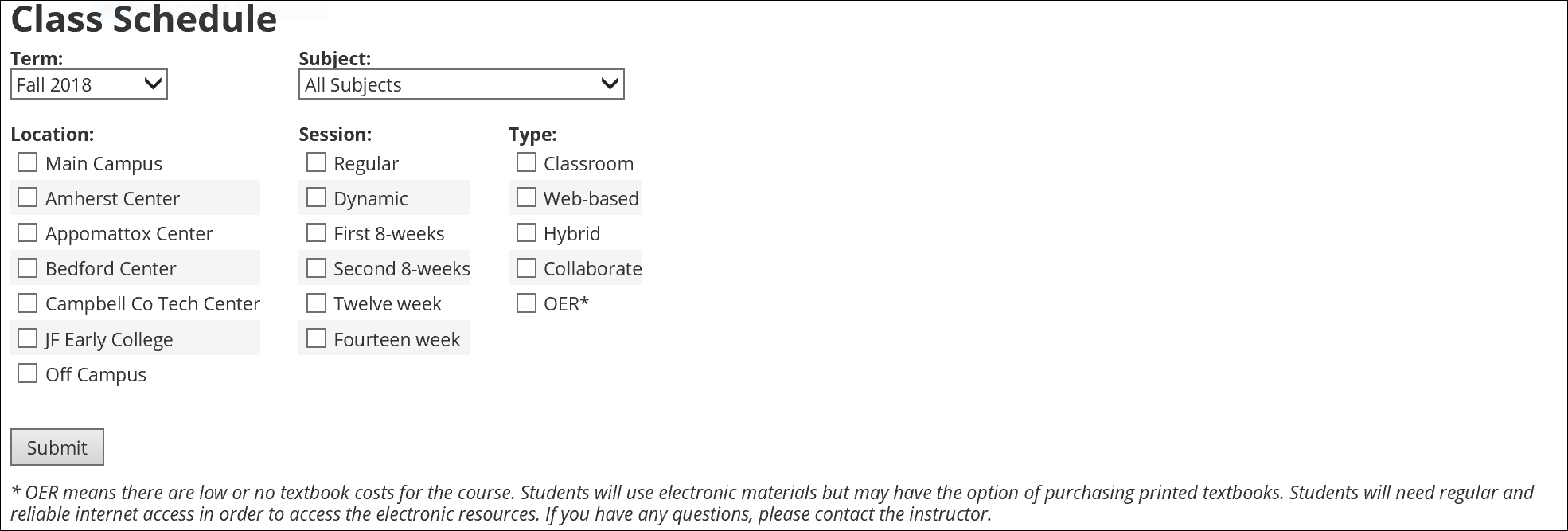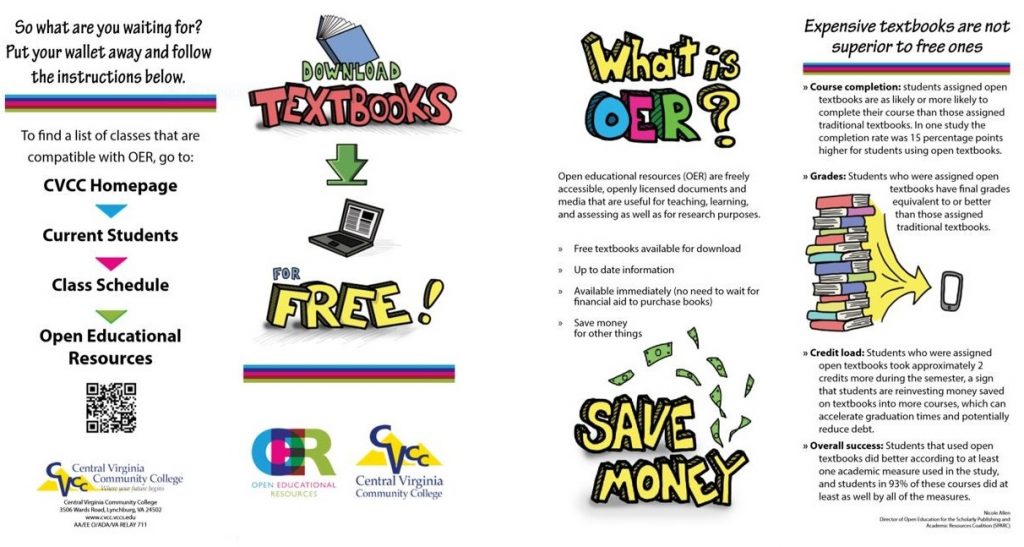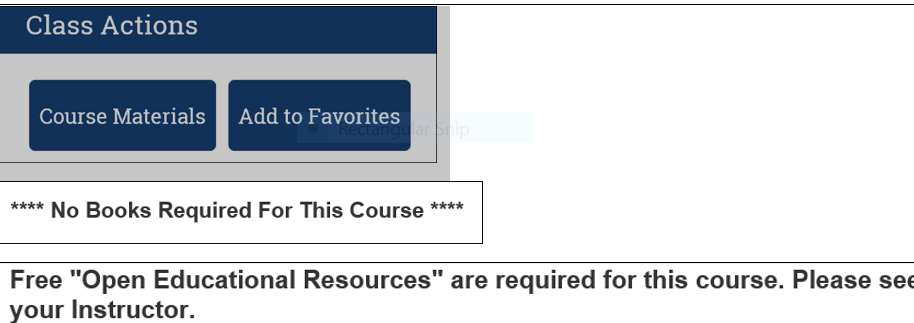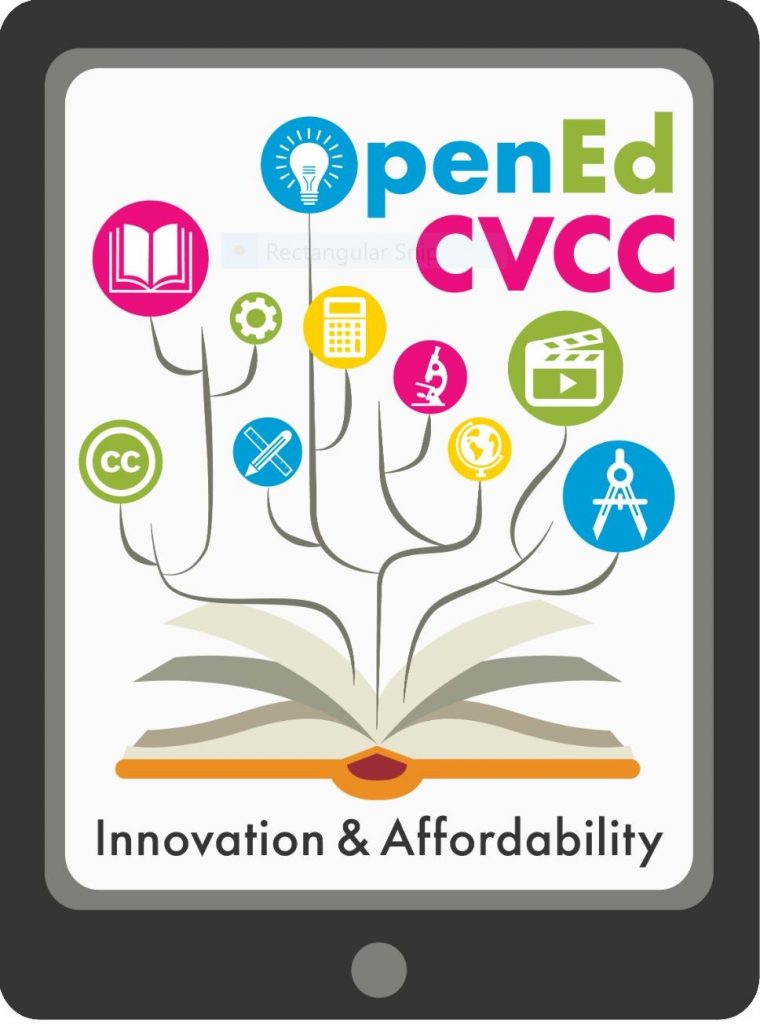18 Central Virginia Community College
Juville Dario-Becker
Virginia
Type of Institution: Community college
Impetus: Zx23 grant; Achieving the Dream funding; Virginia House Bill 2380
Student Information System: Developed internally by college information technology personnel
Markings Used: OER (Type of Class); Zero and Low Cost (class attributes)
Background
Central Virginia Community College (CVCC) offers two-year associates and certificate programs, as well as career and technical education degrees. Regardless of the program, the continuing rise in textbook cost has been a major hurdle for most of our students. In Summer 2015, CVCC applied for and received the Zx23 grant from the Virginia Community College System (VCCS) Chancellor Innovation Fund and the Hewlett Foundation. The Z stands for “zero textbook costs” and 23 represents the number of community colleges in Virginia under the umbrella of the VCCS. The grant enabled us to redesign 12 courses as open educational resources (OER) courses. At CVCC an “OER course” is defined as a course that uses materials that are openly licensed, uses some additional content which is copyrighted but used with expressed permission from the copyright owners granted to the faculty on a case-by-case basis, or is taught with materials that have a total cost less than $40. One stipulation of the grant was that these OER courses be duly identified in one form or another in the course catalog and in the student information system (SIS) for the benefit of not only CVCC students but also all VCCS students. The information technology (IT) department, website committee, webmaster, academic divisions, Office of Enrollment Management, and college bookstore manager worked together to create a course schedule that is streamlined for students interested in identifying the different course attributes. IT personnel created the CVCC internal SIS coding system that allowed for the identification and marking of OER courses in the course catalog.
CVCC implemented the course marking system for OER courses in Summer 2016. There was no initial data collection on how many students were actually helped by the course markings. During the same term, the college received funding from Achieving the Dream, which extended the initial work done with the Zx23 grant. As of 2019, CVCC offered 35 OER courses. The OER course marking currently in place is now a handy tool relied upon by students and academic advisers when developing a student’s academic course plan.
The OER course listing marks the courses that utilize OER and do not require the purchase of a textbook, as well as courses that use low-cost learning materials. In short, some of the courses marked are taught strictly with OER, and other courses use both OER and low-cost materials. These distinctions are not apparent in the course catalog. All other courses list the cost of new, used, or rental textbooks. When students access a course in the online course listing, they can find information on the learning materials that they need, including non-textbook ancillaries such as laboratory kits and nitrile gloves. Some course attributes instruct students to communicate with the assigned professor for further details (see figs. 18.1-4).




Reporting OER Courses
Identifying and marking OER classes in the SIS is an ongoing collaborative effort among many constituents within the institution, starting with the instructor, the division administrative assistants, division deans, and the dean of enrollment management. The college does not require or assign instructors to teach their classes as OER but they are encouraged to adopt existing OER classes for teaching their assigned sections. Instructors opting to teach OER classes must inform the division administrative assistants verbally, or through other means of communication, as to which classes and sections they will be teaching the following term. Currently, there is no formal protocol or formal paperwork to be completed for teaching an OER section. In the foreseeable future, this situation will have to be addressed as CVCC continues to develop and teach additional OER courses.
Stakeholder Feedback
The CVCC community is just getting used to the OER course offerings. Some academic counselors and faculty advisers are still not aware of course sections that have no textbook costs. In addition to the OER course marking in the SIS, we are also making every effort to publicize our OER initiative through promotional materials, such as OER posters and brochures (see fig. 18.5) that are now included in every high school recruitment packet the counselors hand out when they visit area high schools.

Students who have benefited from OER courses during the past semesters are the best ambassadors for the OER initiative. Students have spoken and provided testimonials during convocation and town hall meetings on how OER courses helped them financially. They often wholeheartedly recommend OER courses to incoming and current students. Lately, some parents of early college and dual enrollment students are also beginning to inquire about OER. Moving forward, CVCC will introduce the benefits of OER and work with librarians, faculty of nearby institutions, and area superintendents, principals, teachers, and guidance counselors.
Challenges
As with any new project, CVCC has experienced growing pains as a result of the course marking initiative. These complications are often related to miscommunication, inconsistent language and misinformation, or lack of knowledge.
Misconceptions
Some students believe OER-marked courses are taught only online. Consequently, they bypass or ignore these sections in favor of the non-OER sections. Many students experience some disconnect or discomfort when it comes to accessing academic materials online. When they select their courses and check the OER button, it helps that there is a brief description about content delivery and an option to purchase a printed copy of the materials, when available. Sometimes, the assurance of print copies availability is enough to allay their fears.
Inconsistent Language and Misinformation
Another attribute of all courses taught at CVCC is a link to information on Course Materials. At this time, there are inconsistencies in the language used for different courses, even when all of these courses utilize OER.
If the individual faculty does not inform the division or the bookstore of course material preferences, the bookstore resorts to the “No Books Required for this Course” default (see fig. 18.6). This creates misinformation, leading some students to believe they do not have to read anything since there are no textbooks required. Students who are later told that they need to download a textbook after registering for a no-textbook class complain, often to the administration. Other courses may have the “Free ‘Open Educational Resources’ are required for this course. Please see your Instructor” designation included in course information. The faculty, bookstore personnel, and the webmaster will have to agree on a common language to communicate the information about the specific courses to avoid confusion.

Recommendations
- Communicate often and clearly with everyone involved in project implementation.
- Always give IT personnel a heads up and a reasonable timeline to work on additions and changes in course markings. Once the infrastructure is in place, the day-to-day maintenance falls on the division administrative assistants, with input from individual faculty, to mark new courses or change the code of a class if the assigned faculty does not want to teach with OER. The division deans need to remind the faculty that the information available to students about the attributes of the sections they teach depends upon their timely input to administrative assistants. Information on course material availability is the responsibility of the instructor and the bookstore personnel, in collaboration with IT (usually the webmaster), to ensure the posted information on course materials is accurate.
- When creating logos and other promotional materials, solicit input from faculty, administrators, marketing and media specialists, as well as students. In December 2018, CVCC re-named (or re-branded) the OER initiative as the “OpenEd CVCC: Innovation and Affordability” with a newly created logo for new promotional materials (see fig. 18.7).

Courses that do not require students to spend money for textbooks. May be achieved through the use of OER, library-licensed content, or other free resources.
Free teaching and learning materials that are licensed to allow for revision and reuse.
Also called Course Timetable or Course Schedule Platform: a college or university’s exhaustive listing of courses and programs currently and historically offered, including course titles and descriptions; course catalogs may also contain information about an institution's policies and procedures.
Also called Registration System, Course Timetable Software or Course Schedule Platform: a web-based application designed to aggregate key information about students, including demographic information, contact information, registration status, degree progression, grades, and other information. Some SISs assist students with enrollment, financial aid processes, and final payment for courses.
Also called attributes, designations, tags, flags, labels: specific, searchable attributes or designations that are applied to courses, allowing students to quickly identify important information to aid in their decision making and allow them to efficiently plan their academic careers. Course markings may include letters, numbers, graphic symbols, or colors and can designate any information about a course, including service learning status, additional costs, course sequencing requirements, and whether the course fulfills specific general education requirements.
An organization that assists community colleges with sustainable institutional transformation to increase student success, especially of low-income students and students of color. One initiative for their network of community colleges focuses on the increased adoption of OER.

